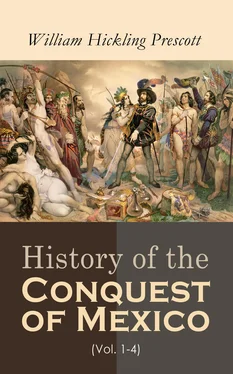In 1850 he made a short visit to Europe, spending some time upon the Continent but more in England and Scotland. Everywhere he was lionized in a way that would have turned the heads of most men. The University of Oxford made him a D.C.L. The doors of the houses where learning was honored opened at his approach. His own charming personality was, however, one of the greatest factors in his social success. As a man he was most lovable.
Upon his return to America he devoted himself to writing the “History of the Reign of Philip the Second,” for which task he had accumulated an extensive collection of documentary “authorities.” This work was to appear in six volumes, and for it the author was offered £1000 a volume by two publishers. Two volumes were published in 1855 and a third appeared three years later. Macaulay pronounced “Philip the Second” Mr. Prescott’s best work. Its style is more finished, its use of authorities more masterly than in the previous volumes. For dramatic interest the chapters describing the defence of Malta by the Knights of the Hospital of St. John of Jerusalem are quite equal to the account of the “Triste Noche,” of Cortés and his companions in Mexico, which so excited the admiration of Stirling. But the work was never to be completed. After two volumes had appeared, there was published “Prescott’s Edition of Robertson’s Charles the Fifth.” This was simply a new edition of the Scottish historian’s work, with additions dealing with the later years of the Emperor’s life which Robertson had not treated. In it is given the true story of the emperor’s retirement and death. Mr. Prescott had for Robertson a very great admiration. He always acknowledged his deep obligation to him, and he felt that it would be most unnecessary, and in fact almost presumptuous, for him to attempt to re-write a history which the Scottsman had written so well. In these three works, “Ferdinand and Isabella,” “Charles the Fifth,” and “Philip the Second,” a century and a half of the most important part of Spanish history is presented. That Prescott did not live to complete the third must always be regarded as a great calamity by the literary world.
Besides the volumes already specified, another, of “Miscellaneous Essays” (a selection from his earlier contributions to reviews and other periodicals) has always been included in Prescott’s published works. To the historical student this volume is even more interesting than to the general reader. It illustrates the change, which, since its publication, has taken place in the methods of the reviewer and of the writer of history as well.
On February 4, 1858, Mr. Prescott was stricken with paralysis. The shock was a slight one. He soon recovered from its effects and continued with undaunted perseverance his literary work. In less than a year, January 28, 1859, while at work in his library with his secretary, he fell back speechless from a second attack and died an hour or so afterwards.
It is quite within bounds to say that no historian’s death ever affected more profoundly the community in which he dwelt. Other authors have been respected and admired by those with whom they came in contact, Prescott was universally loved. No American writer was perhaps more sincerely and more widely mourned. Affable, generous, courtly, thoughtful for others, singularly winning in his personal appearance, he had drawn the hearts of all his associates to himself, while the gracious, kindly humanity manifested in every page of his writings had endeared him to thousands of readers in all parts of the world.
Mr. Prescott’s distinguishing characteristic was his intense love for truth. As an author he had no thesis to establish. He never wasted time in arguments wherewith to demonstrate the soundness of his views. His single desire was to set forth with scrupulous accuracy all the facts which belonged to his subject. Some critics will have it that his tendency towards hero-worship occasionally leads him into extravagance of statement and that his gorgeous descriptions sometimes blind us to most unpleasant facts. This is possibly partly true in the case of “Ferdinand and Isabella,” his first work, but even in those volumes the reader will almost always find footnotes to establish the author’s statements or to indicate the possibility of a doubt which he himself felt. In clear grasp of facts, in vivid powers of narration, combined with artistic control of details, no historical writer has exceeded him. The power of philosophical analysis he did not possess in so high a degree, but no philosophical historian of the first rank was ever so widely read as William Hickling Prescott has been and still is.
For the additional knowledge concerning the historian, which will unquestionably be desired after a perusal of his writings, the reader is referred to the charming biography, published by George Ticknor in 1864, and reissued with this edition of Prescott’s works.
More than thirty years have elapsed since the last revised edition was presented to the public. Its editor, Mr. John Foster Kirk, was pre-eminently fitted for his work. He had been Mr. Prescott’s private secretary for eleven years, and was perhaps more familiar than was any other man with the period of Spanish history of which Prescott wrote. He had, moreover, himself achieved a most enviable international reputation by his “Life of Charles the Bold.” In his notes he condensed the additional information which a generation of scholars had contributed to the subjects treated of in Prescott’s pages. Those notes are all incorporated in the present edition.
But since Kirk’s notes were penned another generation of students has been investigating the history of Spain—a generation which has enjoyed more abundant opportunities for research than any scholars before had known. Numberless manuscripts have been rescued from monastic limbo, the caked dust of centuries has been scraped away from scores of volumes in the public archives, and the searchlights of modern scientific investigation have been turned upon places that once seemed hopelessly dark. As if this were not enough, explorers from many lands have plunged into the depths of the Mexican forests, and penetrated the quebradas of the Andes, in attempts to wrest from them the secrets of their ancient history.
The result is an immense number of volumes filled with statements startlingly diverse and with conclusions widely conflicting. Many of these volumes, especially those that emanated from the explorers, were written by men unskilled in historical writing,—special pleaders, and not historians,—men who were more anxious to demonstrate the soundness of their own theories than to arrive at absolute knowledge concerning the institutions of Peru and of Mexico.
It has been the task of the editor of this edition to separate from this mass of material the conclusions in which scholars for the most part agree, and to embody those conclusions in additional footnotes. He has not ordinarily deemed it necessary to specify the authors read. Because he knows that the average reader abhors quotations hurled at him in unfamiliar tongues, he has, in quoting, always used the best known authority in English.
In preparing these new volumes for the press the texts of editions previously issued have been carefully compared in order to insure perfect accuracy. In all such matters the publishers have aimed to put forth Prescott’s writings in the form that must be regarded for many years to come as the standard edition of America’s most popular historian.
WILFRED H. MUNRO.
Brown University,
December 20, 1904.
Table of Contents
THE publication of Prescott’s second work, “The History of the Conquest of Mexico,” was justly regarded as the greatest achievement in American historical writing. The theme was not a new one. Other writers had essayed to tell the story of Hernando Cortés and of the marvellous empire which that daring and resourceful captain had converted into a province of Spain, but never before had one attempted the task in whom patient research, careful reflection, and brilliant historical imagination were so happily blended. The result of Prescott’s labors was hailed with delight throughout the English-speaking world. His work was speedily translated into many languages and his subject acquired an interest which it has never since lost. To use the words of another American scholar, [1]who did not agree with Prescott in many of the conclusions he reached respecting the so-called Aztec civilization, “It called into existence a larger number of works than was ever before written upon any people of the same number and of the same importance.”
Читать дальше












